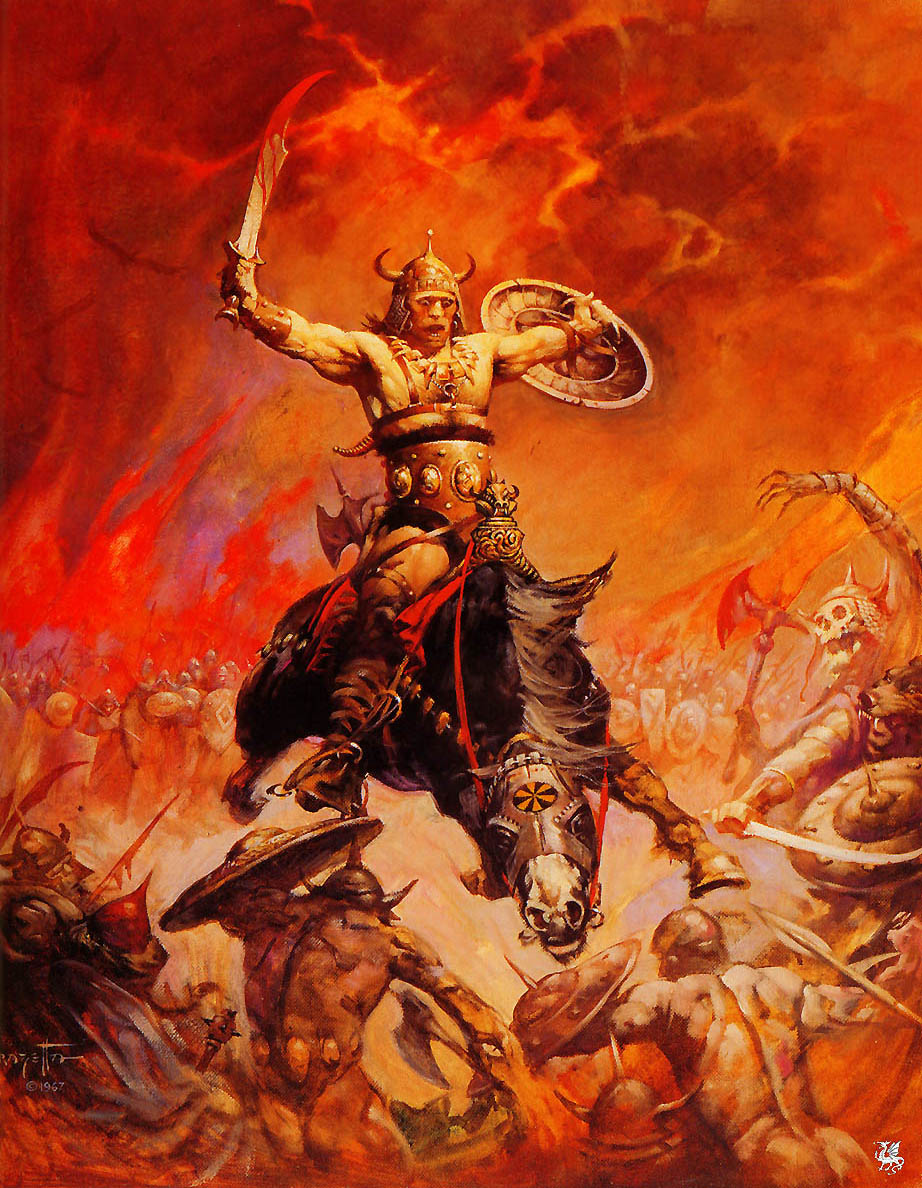

|
|
|
|
|
| [4.0] MORALE, DISCIPLINE AND COMMAND |
|
[5.0] INITIATIVE PHASE |
|
| [7.0] MOVEMENT PHASE | [8.0] MELEE PHASE | PART 3. THE INTERMEDIATE GAME | [9.0] HEROES AND COMMANDERS |
| [10.0] MISSILES AND ARTILLERY | [11.0] SPECIAL MOVEMENT | PART 4. THE ADVANCED GAME | [12.0] WEATHER CONDITIONS AND NIGHT BATTLES |
| [13.0] SPECIAL CREATURE ABILITIES | [14.0] MAGIC | [15.0] FLYING COMBAT AND MOVEMENT | [16.0] CAMPAIGN RULES |
| Army Roster Sheet | Scenario Book | The Art of 3D Gaming | AD&D |
| BATTLESYSTEM Game Options Underground | - | - | Designer's Notes |
| Clangeddin Silverbeard (god of battle) | - | - | Kiri-Jolith (god of battle) |
Table of Contents +
PART 1. INTRODUCTION TO BATTLESYSTEM +
GAME PARTS +
GETTING STARTED +
[1.0] SEQUENCE OF PLAY +
[1.1] INITIATIVE PHASE +
[1.2] INITIAL MISSILE PHASE +
[1.3] RALLY PHASE +
[1.4] MOVEMENT PHASE +
[1.5] MISSILE & MAGIC PHASE +
[1.6] MELEE PHASE +
[1.7] END OF GAME ROUND PHASE +
[2.0] COUNTERS, SCALE AND UNIT ORGANIZATION +
[2.1] GROUND SCALE +
[2.2] COUNTER RATIOS +
[2.3] COUNTER SCALE +
[2.4] MOUNTING MINIATURE FIGURES +
[2.5] SPECIAL COUNTERS +
[2.6] TYPES OF UNITS +
[2.7] INDIVIDUALS +
[2.8] REGULAR UNITS +
[2.9] SKIRMISH UNITS +
[2.10] MOBS +
[2.11] SPECIAL UNIT TYPES +
[3.0] SETTING UP +
[3.1] ARMY ROSTER SHEET +
[3.2] HEROES AND COMMANDERS ROSTER SHEET +
[3.3] CHARACTER RECORD SHEETS +
[3.4] ARMY PLACEMENT +
[3.5] MEASUREMENT +
[4.0] MORALE, DISCIPLINE, AND COMMAND +
A. MORALE +
[4.1] DETERMINING BASE MORALE +
[4.2] DETERMINING CURRENT MORALE +
[4.3] HOW TO CHECK MORALE +
[4.4] WHEN TO CHECK MORALE +
[4.5] EFFECT OF MORALE CHECKS +
B. DISCIPLINE +
[4.6] DISCIPLINE +
C. COMMAND +
[4.7] DEFINITION OF COMMAND +
[4.8] COMMAND RADIUS +
[4.9] CHARISMA BONUS +
[4.10] COMMAND HIERARCHY +
PART 2. THE
BASIC GAME +
[5.0] INITIATIVE PHASE +
[5.1] TEAM INITIATIVE +
[5.2] INDIVIDUAL INITIATIVE +
[6.0] RALLY PHASE +
[6.1] CONDITIONS FOR RALLY +
[6.2] HOW TO RALLY +
[6.3] IF THE UNIT IS RALLIED +
[6.4] IF THE UNIT DOES NOT RALLY +
[6.5] OUT OF COMMAND UNITS +
[6.6] GIVING ORDERS TO A MOB +
[7.0] MOVEMENT PHASE +
A. FORMATIONS +
[7.1] DEFINITION OF FORMATION +
[7.2] CLOSED FORMATION +
[7.3] OPEN FORMATION +
[7.4] SKIRMISH FORMATION +
[7.5] MOB FORMATION +
[7.6] CHANGING FORMATION +
B. MOVEMENT +
[7.7] HOW TO MOVE +
[7.8] MOVEMENT AND ENEMY UNITS +
[7.9] CHANGING DIRECTIONS +
[7.10] CHANGING FRONTAGE +
[7.11] WRAP-AROUND MOVEMENT +
[7.12] FIGHTING WITHDRAWAL +
[7.13] FORCED MARCH +
[7.14] CHARGE +
[7.15] ROUTING +
[8.0] MELEE PHASE +
[8.1] FORCES ELIGIBLE TO FIGHT +
[8.2] WEAPON IN HAND +
[8.3] DETERMINING ATTACK RANGES +
[8.4] MELEE PROCEDURE +
[8.5] DICE CONVERSIONS +
[8.6] MULTIPLE ATTACKS +
[8.7] KILLED AND WOUNDED FIGURES +
[8.8] ENDING A MELEE +
PART 3. THE INTERMEDIATE GAME +
[9.0] HEROES AND COMMANDERS +
[9.1] CHARACTERS AS MEMBERS OF UNITS +
[9.2] CHARACTERS AS COMMANDERS +
[9.3] CHARACTERS AS DEPUTY COMMANDERS +
[9.4] CHARACTERS AS HEROES +
[10.0] MISSILES AND ARTILLERY +
A. MISSILE WEAPONS +
[10.1] WHO CAN USE MISSILES +
[10.2] WHEN MISSILES ARE USED +
[10.3] AMMUNITION +
[10.4] MOVEMENT AND MISSILE FIRE +
[10.5] SPLIT-FIRE +
[10.6] PASS-THROUGH FIRE +
[10.7] INDIRECT FIRE +
[10.8] MISSILE FIRE MODIFIERS +
[11.0] SPECIAL MOVEMENT +
A. CAVALRY AND CHARIOTS +
[11.1] DEFINITION OF TERMS +
[11.2] RATING CAVALRY +
[11.3] RATING CHARIOTS +
[11.4] CAVALRY AND CHARIOT CHARGES +
[11.5] CAVALRY AND CHARIOTS IN MELEE COMBAT
+
B. SPECIAL FORMATIONS +
[11.6] SHIELD WALL +
[11.7] SET SPEARS/PIKES +
C. TERRAIN EFFECTS +
[11.8] TERRAIN EFFECTS ON MOVEMENT +
[11.9] TERRAIN EFFECTS ON COMBAT +
PART 4. THE ADVANCED GAME +
[12.0] WEATHER CONDITIONS AND NIGHT BATTLES +
[12.1] INITIAL WEATHER CONDITIONS +
[12.2] EFFECT OF WEATHER CONDITIONS +
[12.3] SPECIAL WEATHER CONDITIONS +
[12.4] WEATHER MAGIC +
[12.5] NIGHT BATTLES +
[13.0] SPECIAL CREATURE ABILITIES +
[13.1] COMBAT BONUSES AND PENALTIES +
[13.2] POISON +
[13.3] INVULNERABILITY +
[13.4] PARALYSIS +
[13.5] LEVEL DRAINING +
[13.6] AWE AND FEAR +
[13.7] BREATH WEAPONS +
[13.8] REGENERATION +
[13.9] UNDEAD AND MINDLESS CREATURES +
[14.0] MAGIC +
A. RULES AND REGULATIONS FOR MAGIC USE +
[14.1] RESTRICTIONS OF MAGIC USE +
[14.2] GAME SCALE AND AREA OF EFFECT +
[14.3] SAVING THROWS +
[14.4] LINE OF SIGHT +
B. TYPES OF MAGIC +
[14.5] MAGICAL WEAPONS AND ARTILLERY SPELLS
+
[14.6] CHARM, HOLD, AND TEMPORARY IMMOBILIZATION
+
[14.7] BONUSES AND PENALTIES +
[14.8] INVISIBILITY +
[14.9] AWE AND FEAR +
[14.10] CREATE TROOPS +
[14.11] DETECTION AND INFORMATION +
[14.12] MAGICAL DEFENSES +
[14.13] MOVEMENT +
[14.14] ILLUSIONS +
[14.15] MODIFICATION/DISGUISE OF TERRAIN/TROOPS
+
[14.16] REGENERATION AND MAGICAL HEALING +
[14.17] SPELLS THAT ONLY AFFECT INDIVIDUALS
+
[14.18] SPECIAL EFFECTS +
[14.19] CLERICS AND UNDEAD +
[14.20] MAGIC ITEMS +
[14.21] PSIONICS +
[14.22] BARD POWERS +
[15.0] FLYING MOVEMENT AND COMBAT +
[15.1] MOVEMENT +
[15.2] FORMATIONS +
[15.3] COMBAT +
[15.4] BOMBING +
[16.0] CAMPAIGN RULES +
[16.1] RECOVERING CASUALTIES +
[16.2] EXPERIENCE POINTS +
[16.3] CREATING ARMIES +
[16.4] COMMON SENSE +
--------PART 1---------
INTRODUCTION
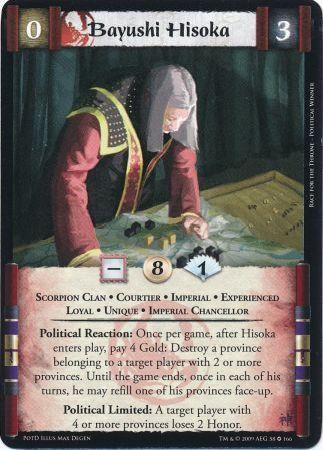
|
|
|
|
|
|
|
|
|
|
|
|
The BATTLESYSTEM Fantasy Combat Supplement
allows you to create fantastic armies on the field of
battle! You command troops && heroes in a war against
the forces of darkness!
The BATTLESYSTEM game is a mass
combat accessory for both the AD&D
and D&D game systems. You must have
either the AD&D game rulebooks or
at
least one of the D&D boxed sets in
order to play. You must play the
BATTLESYSTEM game with
either the
AD&D or D&D game
-- you can't "mix
and match" the systems. Some of these
rules apply only to the AD&D game;
some only to the D&D game.
Most
rules, however, apply to both systems.
This game is designed primarilay to be a
miniatures wargame, but miniatures are
not necessary in order to play.
Both the AD&D and
D&D games
originally grew out of miniatures
wargaming. Many of the rules in the
AD&D and D&D games (such as the
AD&D game custom of giving
movement rates in inches) were derived
from the CHAINMAIL game, designed
by Gary Gygax && Jeff Perren.
The CHAINMAIL Fantasy Supplement was the original inspiration for the
Collector's
Edition of the DUNGEONS & DRAGONS game,
and everything that grew out of it.
With the BATTLESYSTEM game, the
AD&D and D&D games go back to
their roots. You may have wondered
what else you could do with the
miniatures you have collected besides
showing order of march and possibly
running a small melee. The
BATTLESYSTEM game allows you to
fight a large battle using miniatures, and
gives your AD&D && D&D
game
heroes the chance to become military
leaders in your campaign world!
* 1 32-page rule book
* 1 24-page scenario book
* 1 16-page guide to miniatures
* 2 Player Aid Cards
* 2 Metal Miniature Generals
* 3-D ADVENTURE FOLD-UP Figures
* Army Roster Sheets
* 801 die-cut counters
The BATTLESYSTEM Rulebook,
which you are now reading, is the first
part of the package. It tells you how to
play. The Scenario book sets up actual
battles you can fight, and also tells you
how to create your own
BATTLESYSTEM scenarios to go with
your campaign. THE ART OF
THREE-DIMENSIONAL GAMING is a
guide to miniatures--how to buy them,
paint them, mount them, and store them.
That book also tells you how to create
3-D terrain features.
The counters that are included in the
game can be used instead of
miniatures--if, for example, you don't
happen to own 500 orc figures. As you
collect miniatures, you can use the
counters as ready-made "miniature
bases."
There's more to making an exciting
miniatures battle than just buying lots of
miniatures. The rest of the battle is
important, too. So, we've included a set
of 3-D ADVENTURE FOLD-UP figures
that are compatible in scale with the
miniatures.
Finally, to get you started, the package
includes two metal miniatures--generals
and standard bearers. You can paint and
mount them for immediate use.
<img> <img>
This is the first part of the
BATTLESYSTEM game. Read the rules
in this book without trying to memorize
them; this will familiarize you with the
game. The rules are broken down into
Basic, Intermediate,
and ADVANCED Games,
each with an introductory
scenario. If you are an experienced
gamer, you should be able to start with
the ADVANCED Game.
This box contains all the basics for
play. If you already have a large
collection of miniatures, you should start
by mounting them on the counter bases
provided (see THE ART OF
THREE-DIMENSIONAL GAMING and
later sections of these rules) or on bases
of equivalent size. If your miniatures are
already mounted on bases of
approximately the same size, there is no
reason to change them. You can also mix
counters and miniatures as needed. You
will need a large playing surface--a
tabletop at least four feet square is the
minimum (4' x 8' is much better)--with
access on all sides.
These rules are written in a version of
the Case System, which should be
familiar to most wargamers. There are four Parts:
Within the Parts,
there are Sections. Each Section is
numbered (1.0, 2.0, 3.0, etc.) and named
(Sequence of Play, Counters and Scale,
Setting Up, etc.). Starting off each
Section is a general rule or procedure
that tells you what topics are covered in
that section. Within each section are
numbered paragraphs, called Cases. The
Cases are the specific rules for the
BATTLESYSTEM game. Each Case is
numbered in a decimal version of the
Section number (e.g., the first Case in
Section 1.0 is Case [1.1]). Sometimes, a
Case is broken down further; those
sub-cases are labeled with capital letters.
There is one spcial exception that some
wargamers will find unusual: if there are
more than nine Cases in a section, the
case numbering goes from [1.9] to [1.10]
to [1.11], and so on. Don't be confused
by this; just remember that there can be
more than nine cases of a particular
Section.
This game can be played either with or
without a DM or referee.
The Basic Game, Intermediate
Game,
and even some levels of the Advanced Game can
be played without a referee.
If you use invisibility or illusion magic, or
if you use very many high-level spells or
unusual monsters, a referee is strongly
recommended. The referee can be your
DM, or somebody else.
If you are using the BATTLESYSTEM
game in your AD&D or D&D game
campaign, and there is a large battle
involving the forces of evil (controlled by
the DM) and the forces of good
(controlled by the players), it is a good
idea to select an independent referee to
handle invisible movement, spell effects,
and other areas that can cause
controversy. This also lessens the burden
on the DM. The referee (whether or not
he is also the DM) should be the final
arbiter of any rules problems. If you
don't use a referee and you encounter a
rules problem, let common sense and fair
play resolve the problem. (Remember to
record your decision so that it applies in
the future!) If that approach doesn't
work, send your rules questions along
with a stamped, self-addressed envelope
(phrased so a one-word or short answer
can be given!) to Rules Editor,
BATTLESYSTEM Fantasy Combat
Supplement, TSR,
Inc., POB 756,
Lake Geneva, WI 53147.
We'll get back to you.
--------PART 2---------
THE BASIC BAME
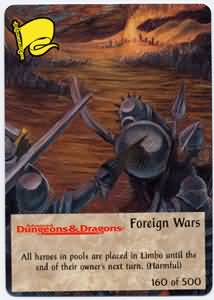
|
|
|
|
|
|
|
|
|
|
The Basic Game covers only the most
essential rules of
the BATTLESYSTEM game. With the
Basic Game, you
can fight a battle between two
small armies. The Basic
Game does not include missiles,
magic, artillery,
or individual characters. Those
rules are given in the
Intermediate
and Advanced Games.
For the purposes of the Basic Game,
Unit Commanders are always assumed to
be fighting with the unit [9.2].
Brigade
and Army Commanders can operate as
independent figures, but Indivdual
Combat [9.4] is not allowed.
THIS ENDS THE BASIC GAME
SECTION. USING THESE RULES, YOU
MAY NOW PLAY THE
INTRODUCTORY SCENARIO,
"BATTLE AT THE CROSSROADS."
--------PART 3---------
THE INTERMEDIATE GAME
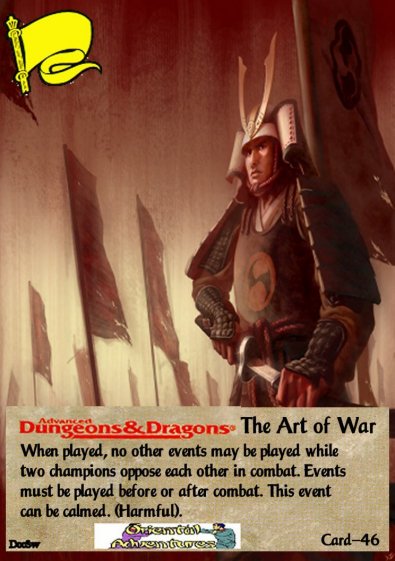
|
|
|
|
|
|
|
|
|
|
The Intermediate Game expands the options avail.
in the Basic Game. With the Intermediate Game,
you can
FIGHT a battle that incl. missiles, artillery,
cavalry,
individual Heroes, special formations, and
terrain
effects. These rules can be adapted to play
any type of
historical minis battle from the dawn of organized
warfare to the intro of gunpowder.
THIS ENDS THE INTERMEDIATE
GAME SECTION. USING THESE
RULES, YOU MAY NOW PLAY THE
INTERMEDIATE SCENARIO, "BATTLE
OF THE BORDERLANDS".
--------PART 4---------
THE ADVANCED GAME

|
|
|
|
|
|
|
|
|
|
The Advanced Game allows you to use the full
range
of options available in the AD&D
and D&D games.
Magic, flying, weather, night battles, and
special
monsters are all available. Finally, the Advanced
Game
provides special campaign rules to allow full
integration
of the BATTLESYSTEM game into your role-playing
campaign.
Unit Name =
Unit Type =
AC =
HD/fig =
MV =
AR =
AR Modifiers =
ML =
ML Modifiers =
DL =
# FIG =
Ratio =
Size =
Unit Commander/Deputy =
Race/Class/Level =
MR% =
PPD =
P/P =
RSW =
BW =
Sp =
Weapon Damage/#AT =
Special Abilities and Limitations =
Heroes and Commanders Roster Sheet
ARMY NAME =
PLAYER NAME =
NAME =
CLASS/LEVEL =
COMMAND RANK =
S =
I =
W =
D =
C =
CH =
MR % =
AC =
CB =
RACE =
PPD =
P/P =
RSW =
BW =
SP =
HD =
CR =
HP =
Mv =
THACO =
AR =
THACO/AR MODIFIERS =
WEAPON/DAMAGE/#AT =
SPECIAL ABILITIES AND LIMITATIONS =
Question: First, my
question is in two parts;
are the stats in the present
Gods,
Demi-Gods and Heroes correct for AD&D,
and since there are no large-scale
battle rules in the DUNGEON MASTER'S GUIDE,
are the rules in Swords and Spells
or Chainmail the official army rules?
If not, what rules are recommended?
Answer: Gods, Demi-Gods
and Heroes was written for OD&D.
There is a revised edition
being written right now by Jim Ward && Rob Kuntz.
This book will be for play
with AD&D. There are no official rules
for army
battles in AD&D
yet. We find that Chainmail works pretty well when we
want to have armies fight
each other. We are presently considering
something along these lines,
but it is in the beginning stages.
(Update: See DEITIES
& DEMIGODS)
(Update: See BATTLESYSTEM).

![]()
Reduce - Reuse - Recycle
PLAYER NAME:
ARMY:
BRIGADE:
UNIT NAME:
UNIT TYPE:
AC:
#FIG:
UNIT COMMANDER/DEPUTY:
HD/fig:
RATIO:
LEVEL/RACE/CLASS:
MV:
SIZE:
MR%:
PPD:
P/P:
RSW:
BW:
SP:
AR:
AR Modifiers:
ML:
ML Modifiers:
DL:
Wpn/Dmg:
SPECIAL ABILITIES AND LIMITATIONS:
UNIT NAME:
UNIT TYPE:
AC:
#FIG:
UNIT COMMANDER/DEPUTY:
HD/fig:
RATIO:
LEVEL/RACE/CLASS:
MV:
SIZE:
MR%:
PPD:
P/P:
RSW:
BW:
SP:
AR:
AR Modifiers:
ML:
ML Modifiers:
DL:
Wpn/Dmg:
SPECIAL ABILITIES AND LIMITATIONS:
UNIT NAME:
UNIT TYPE:
AC:
#FIG:
UNIT COMMANDER/DEPUTY:
HD/fig:
RATIO:
LEVEL/RACE/CLASS:
MV:
SIZE:
MR%:
PPD:
P/P:
RSW:
BW:
SP:
AR:
AR Modifiers:
ML:
ML Modifiers:
DL:
Wpn/Dmg:
SPECIAL ABILITIES AND LIMITATIONS:
UNIT NAME:
UNIT TYPE:
AC:
#FIG:
UNIT COMMANDER/DEPUTY:
HD/fig:
RATIO:
LEVEL/RACE/CLASS:
MV:
SIZE:
MR%:
PPD:
P/P:
RSW:
BW:
SP:
AR:
AR Modifiers:
ML:
ML Modifiers:
DL:
Wpn/Dmg:
SPECIAL ABILITIES AND LIMITATIONS:
Heroes and Commanders Roster Sheet

ARMY NAME:
PLAYER NAME:
NAME:
RACE:
CLASS/LEVEL:
COMMAND RANK:
S:
I:
W:
D:
Co:
Ch:
MR%:
PPD:
P/P:
RSW:
BW:
Sp:
AC:
HD:
hp:
THACO:
CB:
CR:
MV:
AR:
THACO/AR Modifiers:
SPECIAL ABILITIES and LIMITATIONS:
ARMY NAME:
PLAYER NAME:
NAME:
RACE:
CLASS/LEVEL:
COMMAND RANK:
S:
I:
W:
D:
Co:
Ch:
MR%:
PPD:
P/P:
RSW:
BW:
Sp:
AC:
HD:
hp:
THACO:
CB:
CR:
MV:
AR:
THACO/AR Modifiers:
SPECIAL ABILITIES and LIMITATIONS:
ARMY NAME:
PLAYER NAME:
NAME:
RACE:
CLASS/LEVEL:
COMMAND RANK:
S:
I:
W:
D:
Co:
Ch:
MR%:
PPD:
P/P:
RSW:
BW:
Sp:
AC:
HD:
hp:
THACO:
CB:
CR:
MV:
AR:
THACO/AR Modifiers:
SPECIAL ABILITIES and LIMITATIONS:
ARMY NAME:
PLAYER NAME:
NAME:
RACE:
CLASS/LEVEL:
COMMAND RANK:
S:
I:
W:
D:
Co:
Ch:
MR%:
PPD:
P/P:
RSW:
BW:
Sp:
AC:
HD:
hp:
THACO:
CB:
CR:
MV:
AR:
THACO/AR Modifiers:
SPECIAL ABILITIES and LIMITATIONS:
I'd like to respond to Brian Hook's letter in
DRAGON #103. Brian argues that the BATTLESYSTEM
and War Machine rules take away
from the essence of role-playing. He believes that
role-playing should be about individual characters,
not about mass-combat battlefield decisions,
and says that the latter "takes away the flavor of
role-playing, and changes the D&D and AD&D
games into war games." He goes on to point out
that "saying the BATTLESYSTEM supplement
is part of a RPG is like saying games
such as Blitzkrieg are actually RPGs. (Aren't
the players role-playing generals?)"
Obviously, as the editor of the
BATTLESYSTEM Supplement and as designer
of D&D and AD&D modules that
feature
BATTLESYSTEM battles (H1, Bloodstone Pass,
and X10, Red Arrow, Black
Shield), I disagree. I
think that the BATTLESYSTEM and War
Machine rules add to, not take away from, the
"essence of role-playing."
Brian asks, "Which takes more personality:
playing a character going into a dungeon, fighting
it out individually and making difficult decisions
such as "Which door?" or how to avoid a
monster; or, making mass-combat battlefield
decisions?" Actually, it doesn't take any personality
to decide "which door" or to roll dice and
fight a monster. As I'm sure Brian realizes, a
character's personality is better revealed outside
the mechanics of a melee. One character rolling
dice and calling out "to hit" numbers sounds
mighty like another. Role-playing (as opposed to
roll-playing) takes place in every part of a character's
game life, whether he's dungeon crawling or
leading great armies into battle.
The difference between "role-playing" a
general in Blitzkrieg and role-playing an Army
Commander in BATTLESYSTEM is twofold. In
the 1st place, a BATTLESYSTEM Army Commander
is a D&D or AD&D character who has
been on many adventures, worked his way up to
respectable levels, and developed a personality
and goals. Secondly, the BATTLESYSTEM rules
are designed to encourage generals to fight alongside
their troops, get involved in heroic combat,
and, in Brian's words, to "have FUN and inflict
casualties in a wonderful hack-and-slash routine."
The best role for a PC to play in a
BATTLESYSTEM combat is that of a Hero. The
player gets the best of both worlds -- the challenge
of leading a large army and the thrill of
individual combat.
Of course, the best argument against Brian's
point of view comes from Brian's own letter. He
says, "There has been only 1 circumstance in
which I have used massive war game rules, and
that was when a 12th-level Lord was
the highest
and most respected character in a village, though
somewhat of a recluse. He was voted to lead the
village into battle against the invading orcs (15
orcs against 70 0-level, able-bodied villagers)."
That's a great example of how to integrate mass-combat
rules into a role-playing (not roll-playing)
campaign. He used the character's personality,
objectives and situation to create a new kind of
challenge, distinct from dungeon crawling, wilderness
exploration, or big-city prowling. In the
various TSR modules that contain
BATTLESYSTEM scenarios, I think Brian will
find the same thing: mass-combat in the context
of role-playing, designed to give advanced players
new challenges and more FUN. (H1, Bloodstone
Pass, which features high-level PCs leading 0-level
troops against a numerically stronger opponent,
is similar to the battle Brian mentions.)
According to the DMG (for the AD&D game)
<TERRITORIAL
DEVELOPMENT BY PCs>
<CONSTRUCTION>
<FOLLOWERS FOR UPPER
LEVEL PCs>
or the Companion Set (for the D&D game), high-level
characters are supposed to acquire castles
and land, to become Barons with realms of their
own. There's certainly a great context in historical
fantasy for this. (Conan, whom Brian mentions,
is a case in point.) What distinguishes a
high-level campaign from a low-level one? It isn't
just the number of HD of the monsters you
face . . . at least, it shouldn't be. Both the
BATTLESYSTEM Supplement and the War
Machine rules allow you to make your high-level
campaign qualitatively, not just quantitatively,
different from your low-level campaign. Yes, your
PCs should fight alongside your troops. Yes, you
should do more than just "move markers and roll
dice." YES, if you play BATTLESYSTEM or War
Machine scenarios without integrating them into
your role-playing campaign, you're just playing a
normal war Game. But there's a lot more to it
than that.
The BATTLESYSTEM Supplement and the
War Machine aren't the be-all and end-all of role-playing.
They're another option, nothing more.
They allow you to simulate more of the worlds of
heroic fantasy. Wars are important parts of the
world we play in, and the Game system would NOT
be compleat without the option of mass combat.
Brian, I hope you give it a chance.
Michael Dobson
Lake Geneva, Wis.
(Dragon #107)
"Gary's Notes"
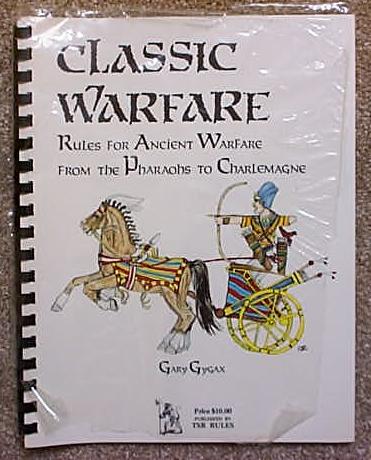
John
Stark wrote:
Gary,
thanks for tackling my queries! Here's another one if you don't mind.
Did wargaming (i.e., using Chainmail and whatnot, or the later Battle System) make it into your campaigns in the early days of D&D (say through the 70's and into the early 80's)? All of the stuff in the various rulesets about players getting to "name" level, building castles or strongholds, combined with the advice and rules on hiring/attracting mercenaries, non-human troops, constructing buildings or siege equipment, and so on, always seem to point to the idea that at some point campaigns would (or at least could) move into the realm (ahem) of large scale conflicts, empire building, and so on.
If you
did incorporate wargaming into your campaigns back then, do you have any
wargaming stories, battles, or exploits to share about that element of
the game? Did any of the players in your games build castles and/or armies,
and go on a tear across the lands of Greyhawk?

Short
answer:
No,
we left tabletip miniatures battles behind in favor of the RPG.
When
mass-combat took place the DMs I played with, as well as me personally,
abstracted the battles to contests between the proncipal figures, did quick
attrition of the ordinary forces, and then used morale
to determine when one side or the other broke.
The reason for that is that the players did not want to wargame thay wanted to engage in RPGing.
Cheerio,
Gary
Quote:
Originally
Posted by Gray Mouser
Hey
Gary, a couple things here.
First,
my question: when PC's in your campaign got to higher levels and started
setting up strongholds did they ever engage in large-scale conflicts (viz.,
fielding armies against their foes)?
If
they did was such conflict resolved using Chainmail or did you wing it?

We
never got into any large-scale PC force vs. PC force battles in the campaign.
however,
Rob was the DM for some of Mordenkainen's
roving forays with several thousands of troops, even city siege attacke.
He
winged such, as we both had considerable experience with large-scale military
miniatures battles.
That's
what I did when a large PC force met a large NPC one opposed to it.

Haakon1,
About
all I can add is that a computer can run regular A/D&D combat
rules for an army and have the results done in real time.
Care
would be needed to manage morale rules, for those
would be critical to outcomes.
A programmer
with good knowledge of military miniatures could do it without much trouble--aside
from the
time needed to enter all the data.
When
I run mass combat I fudge the action using a d6 for every 5, 10, or 20
men on a side.
Mounted
troops add 1 to the result. Much tougher units can have a +2 to their dice.
5 wounds, 6 kills.
Wounded
men do not count in the next round's combat rolls.
Morale
depends on what sort of troops are engaged and what leaders they have there
with them.
Cheers,
Gary